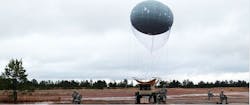U.S. Army extends aerial network with Drone Aviation aerostats during Network Integration Experiment
JACKSONVILLE, Fla., 20 June 2014. U.S. Army personnel used two Winch Aerostat Small Platform (WASP) aircraft from Drone Aviation Corp. (DAC), a developer of specialized lighter-than-air aerostats and tethered drones in Jacksonville, Fla., in the U.S. Army's Network Integration Experiment (NIE) 14.2 at Fort Bliss, Texas, and White Sands Missile Range, N.M.
DAC provided the aerostat systems to the U.S. Army Space and Missile Defense Command (SMDC)/Army Forces Strategic Command.
Army officials requested that the two WASPs take part in NIE 14.2 following their successful evaluation at NIE 14.1 as a System Under Evaluation. The Army's NIEs evaluate and integrate current and prospective systems, driving changing requirements, procurement, and field recommendations.
The Army's Brigade Modernization Command personnel employed the WASPs to extend their aerial network. They flew a Harris PRC-117G radio and antenna mounted to a DAC-manufactured tactical aerostat tethered to a militarized WASP launcher system. Multiple waveforms were supported and extended the communications ranges between eight and 10 times greater than achieved with Army issue OE-254 (30-foot) retransmit antennas.
While stationed at NIE 14.2, the WASP systems were operated solely by junior soldiers who received four days of training prior to the start of the experiment.
The NIE 14.2 exercises are intended to evaluate joint force network capabilities; improve unified land operations with communications nodes based on aircraft and unmanned aerial vehicles; integrate networking technologies into the armored brigade combat team; develop ways to deliver, collect and process integrated, multi-source intelligence to front-line warfighters; and make field command posts more mobile and efficient. The NIE 14.2 exercises also involved beyond line of sight communications; expeditionary signal brigade tropospheric scatter communications; network intrusion prevention; cellular communications; electromagnetic spectrum operation; condition based maintenance; and operational energy solutions.
The WASP is a mobile, tactical, turn-key aerostat system capable of carrying a variety of payloads in support of military operations in the field, giving troops a tactical edge by allowing them to communicate over greater distances. The WASP leverages aerostat technology to elevate network payloads to an advantaged height to enable persistent network connectivity while reducing risk to troops conducting missions. The self contained WASP systems are mounted to a compact trailer for use with various military or commercial vehicles. The WASP systems are engineered to provide significant benefits, including reduced acquisition, maintenance and overall operation costs, smaller footprint necessary for infrastructure and operations, reduced operators required to manage the aerostat, decreased time for inflation/deflation, faster launch and recovery, and a simplified process.

